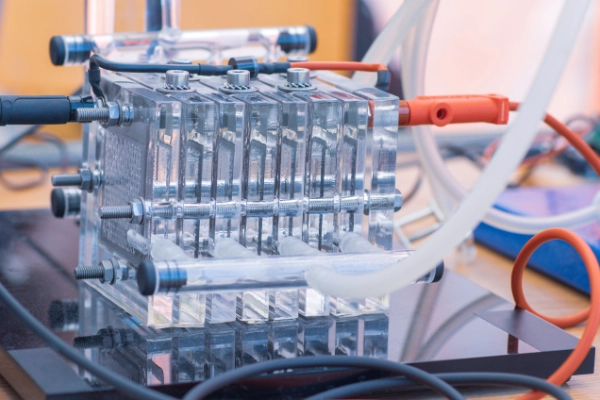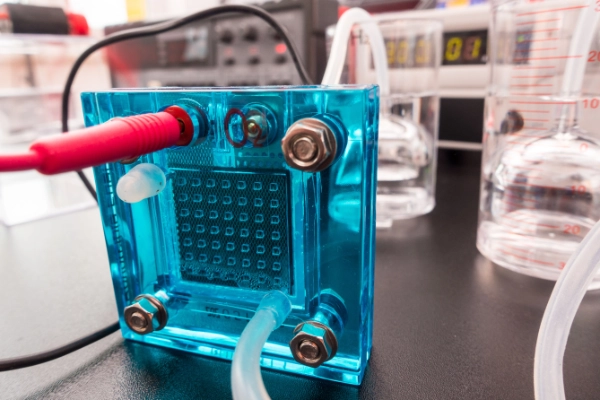Storing & Recovery of Hydrogen
The good news in storing energy in the form of Hydrogen is that it has a very high gravimetric energy content, i.e. it can store more than twice the energy per weight compared to hydrocarbons such as natural gas, petrol or diesel.

However, unfortunately, at the same time it has a very low density. Therefore, its volumetric energy content is much lower compared to many other energy carriers, such as hydrocarbons (about one third of natural gas). This means that storing the same amount of energy with hydrogen requires a tank three times as large or pressure three times as high as natural gas.
This makes the storage and transport of hydrogen difficult, which is why not only the production (Electrolysis) but also the storage of hydrogen requires considerable amounts of energy, e.g. approx. 12 % of the energy content of hydrogen is used for compression to a pressure of 700 bar or approx. 20–30 % for cryogenic liquefaction (cooling to -252,882 °C or -423,188 °F).
Furthermore, evaporation/boil-off occurs during cryogenic hydrogen liquefaction and transport of liquid hydrogen due to unavoidable heat insulation losses. To prevent the pressure in the tanks from rising too much, the hydrogen gas is vented via a pressure relief valve, i.e. during transport losses occur.
Thus, with the rise of the hydrogen economy better and easier manageable hydrogen carriers are needed.
Ammonia Synthesis & Ammonia Cracking
Another excellent possibility to store hydrogen is to convert it to Ammonia. Ammonia is a nitrogen-hydrogen compound and can be stored in liquid form in simple pressure vessels at approx. 8 bar akin to natural gas. Compared to compressed hydrogen, it exhibits even a higher energy density than and does so without the aforementioned challenges in liquifying and transport.
A big advantage of ammonia is, that it is nothing new to produce it in large scale as it is the basic raw material for all nitrogen compounds and is already one of the most widely produced chemicals worldwide with over 200 Mt/y. Therefore, both production know how as well as infrastructure is already existing.
Usually, Ammonia is produced via the Haber-Bosch process where hydrogen reacts with nitrogen from the air in a catalytic reaction. If the hydrogen is generated from renewable sources, it is truly carbon neutral, as no carbon is involved. Therefore, ammonia can be used as an emission-free energy store in a future emission-free energy system.
Ammonia can be used as a direct energy source (simply by burning it) also with the advantage, that existing infrastructure can be used. If so, the exhaust gas must be cleaned from hazardous emissions such as N2O by our gas purification catalysts or emission catalysts. Recovering the hydrogen from the ammonia by "ammonia splitting" or "ammonia cracking" is another possibility, in which the ammonia is fed over a catalyst that releases the hydrogen and nitrogen. The resulting hydrogen then can be used e.g. in a fuel cell or chemical applications.
Different than the above mentioned Haber-Bosch process, which has been around for more than 100 years, the cracking is a less mature and not yet widely applied technology. To enable ammonia as an energy storage for the hydrogen economy a stable and robust toolkit needs to be available.
Heraeus ruthenium catalysts for ammonia cracking are highly active at low temperature while tolerating dynamic conditions, they are able to withstand rapidly changing energy demands and the subsequent ramping up and down of the process. In short, they provide the necessary properties to ramp up hydrogen storage with ammonia.

For the process of recovery and application, Heraeus also offers boil-off catalysts to control the hydrogen slip. Heraeus also serves further processes around Ammonia: Catalytic Gauzes are applied in the Ostwald Process to treat the greenhouse gas N2O that is a by-product of fertilizer production. In combustion engines where ammonia is used, Emission Catalysts take care of N2O abatement.
Methanation to Sustainable Synthetic Natural Gas and BioGas Upgrading
One possibility, to store Hydrogen is to use it to synthezise the energy carriers that has been used already for decades from fossil sources, namely methane. Or in other words: “natural” gas, but synthesized, not taken from fossil sources. The H2 is combined with C02 and reacts to CH4 and H2O. As it consumes C02 when being produced, it is truly carbon neutral (at least if the Hydrogen was generated by renewable energies).
This Synthetic Natural Gas (SNG) is a promising option to store and transport Hydrogen, as it allows the use of the already existing natural gas grids. In the power-to-gas concept, Green Hydrogen is made to react with CO2 via the Sabatier reaction to form Methane.
HeraPur® catalysts based on Ruthenium provide a versatile and durable catalytic tool for this reaction – highly active and especially suited also for a dynamic system operation. Applications for the Methanation may range from very CO2-rich waste gases to pre-purified Biogas compositions.
HeraPur® Ru-catalyst are also available with minimum precious metal loadings for efficient and selective Methanation reactions in the purification of process gases.
Said Biogas is produced by the anaerobic digestion of the organic feedstocks and in its raw form it contains a considerable fraction of CO2. Hence, to be used in the existing infrastructure, in a Biogas upgrading process it needs to be processed to near-pure Biomethane.
Beyond catalysts for Sabatier reaction Heraeus also supplies various other catalytic solutions to this field. Please see our gas purification site for catalysts for Methane purification, DeOxigenation or CO2 Purification up to food grade requirements.
Liquid Organic Hydrogen Carrier (LOHC)
A further possibility to store hydrogen is to utilize a Liquid Organic Hydrogen Carrier (LOHC).
LOHCs are liquids capable of capturing and releasing hydrogen through a chemical reaction. The LOHC, even when merged with hydrogen, can simply be stored or transported at ambient conditions, very similarly to petrol or diesel.
The LOHC is charged with hydrogen through a hydrogenation reaction. This chemical reaction occurs under increased pressure and temperature and with a catalyst present. If the hydrogen is needed again after some time or when the carrier has arrived at its destination, the LOHC is dehydrogenated, and the hydrogen is released. This process also requires an increased temperature and a catalyst. Depending on the applied LOHC agent, Heraeus has tailored catalyst solutions offerings for both the hydrogenation and dehydrogenation process.
Heterogeneous catalysts in these applications are typically based on platinum, ruthenium or palladium, combined with a refrectory metal support like aluminum oxide. Heraeus tailors the catalyst specifically for the respective LOHC molecule and process to deliver optimal performance.
The Heraeus experts are happy to discuss your specific requirements to find exactly the right solution for your LOHC needs.
Read As Well






Your Expert for Storing & Recovery of Hydrogen


